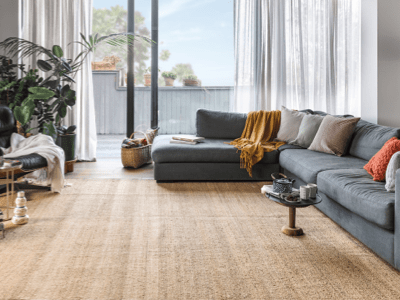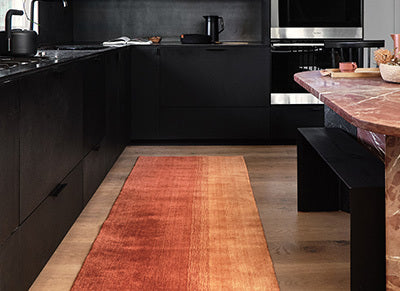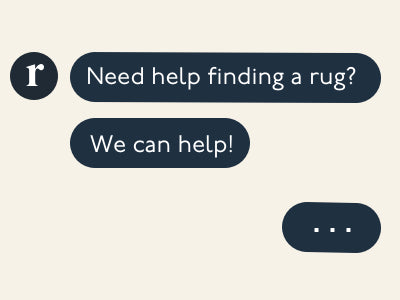Let’s start from the beginning. Tell me about the way you collaborated with the weavers for this project. How was this different from your typical way of working with artisans? What was the process like?
CT: Generally speaking when we’re designing rugs with our partners, we as the design team typically determine the initial designs in house here at Revival and then we send the weavers artwork. It's up to them to interpret the artwork as closely as they can. For this particular series, though, we started by producing six designs as samples, saw the quality, and decided that given how beautiful and special the weave of these rugs is, that we needed to create a collection of one-of-a-kind rugs. They were woven at a women’s cooperative in Morocco.
CP: That’s right -- for this collection, we made the design, specified the sizes and colors, and sent spec sheets to the weavers. We followed this same process for the first 6 samples, determining the sizes based on what size would suit a particular design the best. The weavers made full-sized rugs for these first size designs. Some of the designs came out exactly like the designs we provided, while some had changes made by the weavers.
You can see here a few of the specification sheets for your reference to help you understand what exactly was sent over to the weaver in Morocco, as well as photos of the final rug. As you can see from the photos, sometimes the weavers replicated the design as-is (like Rug#88), but sometimes the weavers added their own interpretation to the design (like Rug#31).

CT: Exactly. The weavers added their own touches: some of the samples came in with beautiful details on the kilim ends, different types of fringe, and subtle graphic design changes from the original artwork. And they looked BETTER that way.
Once those six designs were created, what happened next? How did the rest of the collection come together?
CP: We loved the results we got for the first 6 rugs, so we decided to take it forward and make more designs. All 100 of the designs were made by the Revival design team, with similar spec sheets provided for all 100 designs.
BY: Actually, The Moroccan Project is my first with Revival and one in which I became familiar with the weaving process, since I didn’t have previous experience designing rugs. Christina and Chandni described to me all the steps of the project and walked me through how the weavers weave, how the samples look, what the color options are, and finally the designs they created for the project. Then, instead of working on just the graphical shapes, I started to work on additional designs with the process in mind -- because I had an idea about what the designs might look like on completed rugs thanks to Christina and Chandni.
What were some of the inspirations or starting points for the designs that were sent over to the weavers?
CP: The inspiration behind the designs eventually came from everywhere -- the landscapes of Morocco to Josef Albers. The design team had total freedom to experiment and come up with the most inspired designs! We started with an initial moodboard created for this project, which provided the general feel we were trying to capture in these designs. We wanted the designs and colors to be playful and to work well with the high piles, which add a lot of movement to the designs.
CT: The most important thing we think of when designing for any of our collections is: Will this design serve the beauty of the weave we are using? It all starts with the weave and the weaver. After that, we decided to design the most fun, beautiful rugs we could think of, using all the beautiful colors that were provided to us by the Cooperative.
Speaking of color: could you explain a little bit more about the colors that you used? What kinds of colors were available to you?
CP: The women’s Cooperative provided us with 57 dyed wool color samples (you can see some of the wool hanks on the attached spec sheets). These wool hanks were sent to Christina. She then had the hanks photographed and shared the images with Busra and me so that all three of us had the same color palette. These were the colors that can be easily achieved by the weavers by hand-dyeing Moroccan wool. Even though the colors are based on what is already available, they are all hand-dyed by the weavers.


And what about the wool itself? Where does that come from? How was the pile on each rug determined or decided upon?
CT: The pile height was decided upon from the supplier and the weave sample they sent us. As far as the exact type of wool, I'll need to throw that question over to Salma.
SD:The only wool used is locally-produced Moroccan wool, treated and cleaned artisanally.
Salma, could you speak a bit more about the Cooperative? Where is it located? How do the craftswomen learn their craft?
SD: The Cooperative is located in a village in the central Moroccan Middle Atlas located about 300 kilometers from Casablanca.
The weavers learn their craft from their mothers or aunts; it is an art that is transmitted between family members and from one generation to another. They usually learn just by watching their relatives weaving at home. Nowadays women weave mostly in ateliers, but when a rug is small it can be woven at home. The ateliers are not just a place for weaving but also a place for socialization where women gather and chat.
Let’s talk numbers. In the end, how many designers and artisans were involved?
CT: There were three designers involved in this collection on our end at Revival.
SD: About 70 different weavers were involved in Morocco.
And a few specifics about the rugs: what’s the range of sizes and dimensions?
CP: The sizes vary from 4’x6’ to 8’x10’, with some 8’x8’ squares.

Okay, last question here: any particular pieces in this series that stand out to you as a favorite, whether that’s because of the process it took to make or because of the final result versus its starting point?
CT: There are no individual pieces that stand out to me, only because I love all of them, and the freedom and looseness they were created with. This was a dream project.
CP: I totally agree with Christina on this one. This was my favorite project so far. It felt like I was let loose in a playground to pull off any shenanigans I want. All the designs have turned out amazing!
BY: It was really unique and fantastic for me to begin with this kind of project, knowing that the designs would be turned into a real product in the Moroccan weavers' hands! And it was sooo exciting to know that the weavers would add their own interpretation and to not know what those interpretations would be.
See Long Distance featured in The New York Times Style Magazine, The T List: Five Things We Recommend This Week
Sort & More Filters











 Previous Post
Previous Post
